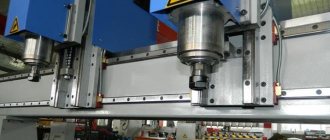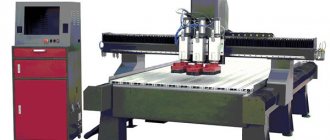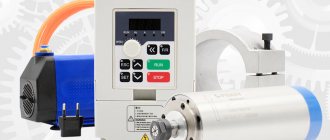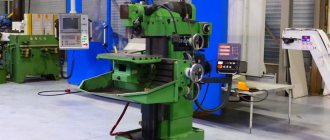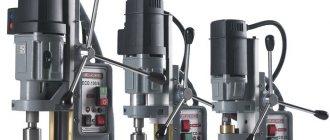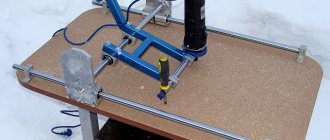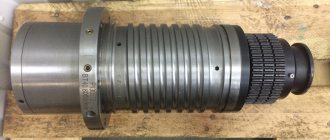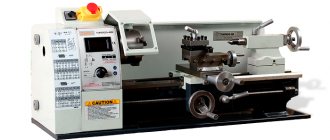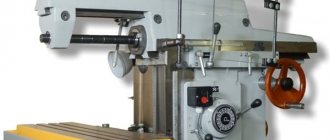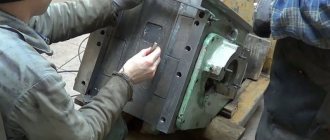The spindle is the motor that spins the cutter on a CNC router. Its main task is to transmit torque to the cutter. Used for milling, drilling metal and wooden surfaces, processing parts, etc.
There can be many key factors in choosing the right spindle for your CNC router. First of all, these are engine power, rotation speed and torque. Secondly, many experts note the quality of the clamping of cutters and other types of cutting tools. In this article we will look at the classification of spindles and find out details about the purpose of each type.
What is a spindle?
At the mechanical engineering department of any polytechnic university they will say that a spindle is a shaft that is used as an intermediate device between the machine and the material being processed. It uses a collet to secure the cutting tool, and the length of the shaft can be adjusted. Spindles are divided into two main types:
Industrial . Used for lateral loading. It has an increased margin of safety and power, you can additionally connect a lubrication system and a cooling system, it is connected and controlled from a CNC controller.
Amateur . A regular drill or low-power milling machine. It is used in everyday life and is used to distribute the load vertically relative to the body of the device. As a rule, such spindles have a simple configuration, are controlled manually, and are not connected to a CNC controller.
A low-power amateur spindle cannot be used for industrial machines. Their configuration easily copes with tension and compression. However, they are not designed for lateral loads. In addition, increasing the spindle speed leads to rapid heating and a decrease in power.
Edge processing - working with a template
It’s easier and faster to process the edges of a regular board using a surface planer, but if you don’t have one, a hand router will also do the job, but it will just take more time. There are two ways: without a template and with a template. If this is your first experience with a router, it is better to use a template. When processing the edges of boards, you need straight edge cutters, and most likely you will need two - with a bearing at the beginning and at the end of the cutting part (pictured).
To process the edge - make a flat surface
As a template, you can use an already processed board or, for example, a building rule. The length of the template should be slightly longer than the length of the workpiece - 5-6 cutter radii on each side. This will make it possible to avoid the cutter “diving” into the material at the beginning and at the end. One important point: the horizontal plane (perpendicular to the one being processed) must be level. In any case, its curvature should not be greater than the gap between the bearing and the cutting part, otherwise the cutter will touch the template, and this is very bad - it becomes imperfect and the applied irregularities will appear on other copies.
Milling machine spindle power
If you are faced with the task of choosing a spindle for a CNC milling machine, first of all you should pay attention to the power parameters of the device. All experts and at all times recommended not to skimp on this parameter. The more power, the more serviceable the device will be.
At the same time, if you purchase a spindle to work with a specific type of material, then you should pay attention to how much power the device will need for this. Plywood, particleboard and fibreboard will require a spindle with a power of 1500-3000 W. Natural wood and soft metal alloys will require up to 5000-6000 W.
Depending on the type of work performed, there are the following requirements for spindle power:
- 500 to 600 W is usually required for general drilling and engraving,
- from 900 to 1500 W will be needed for processing solid wood,
- more than 1500 W will be needed for CNC machines designed for intensive work on an industrial scale.
Old Soviet models of wood and metal machines
Soviet equipment is still in use in production. Some people fundamentally prefer to equip their home workshops with units from the USSR.
Important!
It is sometimes difficult to find equipment or components for Soviet equipment in case of breakdown.
Screw-cutting lathe IT-1M
The lightweight machine was intended for gaining practice in workshops. Allows you to process cylindrical workpieces from the outside, drill and boring, and cut threads. Currently out of production.
Screw-cutting lathe TV-6
Appeared on the market in the 80s. It is mainly used for training future turners in workshops and training centers. Allows you to perform basic operations.
Characteristics:
- Spindle diameter - 12 mm.
- Spindle speed - 130-170 rpm.
- The distance between centers is 350 mm.
- The maximum processing length is 300 mm.
Lathes Universal 2 and Universal 3
Tabletop machines for the production of small parts. Most turning jobs are possible. The maximum diameter and length of the workpiece is 12.5 cm and 18 cm.
Lathe TSH-3
Performs the function of a sharpening and grinding unit. Suitable for use in home workshop and industrial purposes. In addition to classical turning work, the unit is suitable for finishing grinding of products and sharpening cutting and metalworking tools.
1E61M, 1E61PM, 1E61VM screw-cutting lathes
Refers to special machines that provide higher processing accuracy. All three modifications belong to the turning-screw-cutting group with a height above the centers of 175 mm.
The diameter of the processed rod does not exceed 32 mm. The maximum movement distance of the caliper is 200 mm.
Screw-cutting lathe 1М63Н
Multifunctional unit designed to perform all types of turning operations. This model also allows you to work with conical surfaces and cut multi-start threads.
The letter H in the marking indicates the ability to obtain dimensions of normal accuracy. It is possible to install additional equipment when working with large-sized workpieces.
Turret lathe 1341
The turret group machine allows processing using several tools at the same time. Available operations:
- Treatment of external and internal surfaces.
- Thread cutting.
- Drilling, countersinking, reaming.
- Working with shaped surfaces.
Processing is performed in automatic and semi-automatic mode. It is possible to produce parts from rods and piece blanks.
Screw-cutting lathe 1N65
An improved modification of the 1M65 unit. It is possible to process cylindrical and conical parts, as well as complex shaped surfaces.
Specifications:
- The height of the center above the bed and support is 500 and 325 mm.
- Spindle diameter - 128 mm.
- The maximum weight of the workpiece is 5 tons.
- The maximum diameter of the workpiece in the jaws is 870 mm.
Screw-cutting lathe 1M63
Developed in the 50s for processing workpieces made of various metals. At that time, it was a unit with unique characteristics, and it was purchased by large industrial enterprises. It ensured high quality and precision processing when turning products of any complexity.
Screw-cutting lathe 1A616
The unit was produced in the 50s of the last century. In that era, the technical characteristics were among the best. The machine is successfully used in many enterprises to this day.
The equipment is designed for a wide range of work with small workpieces. The letter A indicates particularly high processing accuracy. It is possible to cut modular, inch, and pitch threads without restructuring the kinematics.
School lathe TV-4
Developed for teaching turning in school workshops and training centers. A universal machine suitable for basic turning operations. It is lightweight and small in size, which is why it is popular in home workshops.
Metal lathe Shkolnik TV-7
The machine is manually controlled, designed for processing workpieces 100-300 mm. Supports four speed modes. Allows you to perform basic operations - external turning, boring, cutting metric threads, end processing, drilling holes. Purpose - practical training of future turners.
Tabletop metal lathe TV-16
A machine with small dimensions for performing operations of medium complexity. Available for hole drilling, thread cutting, external turning, boring.
Options:
- The distance between centers is 250 mm.
- The maximum diameter of the workpiece above the bed is 160 mm.
- The spindle hole diameter is 18 mm.
- Power - 0.4-0.5 kW.
Spindle selection: rotation speed
The selection of a spindle based on the motor power characteristics should also be made based on the type of material that is planned to be processed. Each manufacturer publishes a range of speeds at which the router can be used to carve metal or wood. The following are usually considered average values:
- For shallow wood engraving, low-power spindles capable of performing up to 25 - 35,000 revolutions per minute are recommended. When choosing a spindle, it is recommended to choose a model that demonstrates the maximum in a given range. That is, if you only need 24-30 thousand revolutions, but there is an opportunity to use 35, it is better to opt for the latter option.
- For soft metal alloys (aluminum) you will need 13 - 8,000 rpm.
Why does wood require more turns than metal? The answer is actually obvious. For each type of material, cutters of different sizes are used. For metal, for example, solid plates made of hard alloys with a diameter of no more than 16 mm are used. The second aspect is the type of milling. High-speed is used for wood processing . It implies high torque, but low feed. For metal, power milling is used, which requires fewer revolutions, but with a more intense feed.
Cooling
As mentioned above, spindles can be equipped with either air or liquid cooling. The air blower is a conventional impeller mounted on the motor shaft and blowing air over its windings.
The big disadvantage of this type of cooling is the fact that the impeller not only forces air onto the hot motor, but also sucks chips, dust and everything that the cutter cuts out of the workpiece into its housing. Also, when processing at low speeds, air cooling is ineffective, since it directly depends on the rotation speed of the spindle shaft.
The water cooling system does not have such a disadvantage, but when using it, a separate place is required for the reservoir with coolant and proper fixation of the tubes with it on the body of the milling machine, which greatly complicates the design if it is a two-spindle milling machine.
It is much more efficient than an air cooling system, since the speed of fluid flow through the spindle is the same all the time thanks to the use of a special pump. The main condition that must be observed when having a water-cooled spindle is that you cannot turn on the engine without turning on the pump, since in this case it will not cool at all, will overheat very quickly and, as a result, will burn out.
Selecting a spindle manufacturer
On the international market, Chinese and Italian spindles are most widespread. In this regard, a reasonable question arose: which one is better? We are convinced that each manufacturer has its own advantages and disadvantages, and each product is beneficial in its own way.
Italian-made devices are superior in quality and assembly. They have built-in air cooling. They perform excellently at high speeds and exhibit neat carvings.
At the same time, Chinese spindles will cost much less, and are unlikely to yield in quality, since they are still manufactured in the same factories in China as Italian spindles. Thanks to the solid cylindrical body, which is closed with bearing units, it produces almost no vibration while maintaining a stable position on the machine. The power of such a spindle may seem less than that of its Italian counterparts. However, Chinese models are unpretentious to environmental conditions, do not deform from excessive heat and can be used in daily work.
Professional and household appliances
These two varieties differ in their functional tasks, but their technical characteristics and properties can be almost similar. Professional products are suitable for regular use in production or for work purposes with large volumes of tasks. Household devices are designed for use at home, as well as in workshops or in country houses. At the same time, the cost of such devices compares favorably and allows each user to purchase a device without spending the entire budget.
Using a screwdriver at homeSource realstroyservice.kiev.ua
Characteristics of battery devices
Mains powered tools are mainly selected based on power and type of built-in motor. In the case of battery devices, other details also become important. This circumstance is clearly visible in the example of a car engine - even the best and working starting engine will not be able to start the car if the batteries have failed. Batteries have the following important properties:
- Voltage. This factor is influenced by the number of power supplies in the device. Motor power has a direct dependence on this indicator, this is especially evident in the example of modifications of one line. If we are talking about products from different brands or even models from the same manufacturer, but with different specifications, then the characteristics are influenced by other factors.
- Capacity characterizes each element that makes up the entire power supply. For this reason, the voltage may differ, but batteries of the same series have the same capacity. The battery life of the device depends on this value. But the amount of work performed is not necessarily proportional to this indicator. To roughly calculate this amount, it is necessary to take into account not only the capacity, but also the voltage of the power supplies.
Battery types:
- Ni-Cd is one of the oldest, but at the same time reliable and proven technology. Despite the improvement of systems, this type is still used in budget devices. Moreover, such batteries can be installed in both household and professional devices. The main disadvantages are the well-known memory effect and insufficient environmental friendliness of the products. But there are also many notable benefits. Such a battery can be easily stored, it does not lose its properties, is insensitive to high voltage and has a low cost, which can significantly reduce the overall price of the tool.
- Ni-MH boasts greater environmental friendliness. The memory effect is less noticeable here, but the cost increases slightly. It is also necessary to be careful when storing the product, since prolonged exposure to a highly discharged state can lead to damage to the battery.
- Li-Ion is the most modern type that is used in household appliances and most battery devices today. The disadvantages of the two previous varieties are unusual for it, so manufacturers are increasingly choosing this option. Over time, developers release increasingly better models, so tools with such a source can be the best choice when purchasing.
Spindle lock and quick-release chuck
To simplify the replacement of a drill or other working tool, manufacturers produce devices with a special system. The principle of its operation is quite simple - when the engine is running, the shaft rotates freely. But as soon as the motor stops, an instant block occurs and the spindle cannot be turned, even by applying significant force. Such a simple design of the mechanism makes it easier to replace equipment and speed up the execution of production and household tasks. Unfortunately, not all models of cordless tools currently include such a holder. It is mainly installed in high-end professional devices, while ordinary users more often choose common double-coupling cartridges.
Why should you choose us?
Did you need to buy a CNC milling machine spindle? Our store's assortment includes items for all types of milling equipment. We will help you choose a spindle of suitable power to carry out work of all levels of complexity and help you understand the settings and installation of equipment.
Our advantages:
- A wide range of products,
- Knowledge of the matter. We don’t just sell me a product, we really understand the equipment and know how to use it.
- We will help you find a spindle for your machine,
- We provide discounts to regular customers,
- Service maintenance. The spindle always needs maintenance. We will provide it.
Call our store specialists to find out the details of the models presented in the catalog, as well as to find out the specifics of placing an order.
